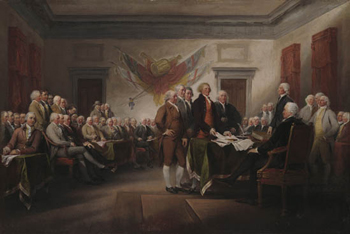
The Declaration of Independence, 4 July 1776

|
It is quite fitting that the most enduring image of the signing of the American Declaration of Independence was painted by John Trumbull: he belonged to a family steeped in the American Revolution. His father was the only colonial governor to support the Revolution, and he himself served in the Continental Army. His family developed a reputation of being patriots, and this probably led to his being commissioned to paint Declaration.
The piece was begun in Paris in 1786, most likely at the suggestion of Thomas Jefferson, though it was not finished until 1817, close to Trumbull's death. Its construction is both reflective of the prevailing European heroic painting tradition of the day and indicative of the impending shift to American documentary realism. The depiction of the participants and the use of light throughout are reminiscent of scenes from Roman history or Christian mythology, an integral part of the European heroic tradition. However, instead of giving its subjects an otherworldly, mythic quality, this serves to visually express the ideals of the Enlightenment, and indicate the signers of the Declaration as men who embody those ideals. The signers stand dignified and auspiciously, seeming to be almost aware of the importance of their impending act. The scene has an impossible uniformity about it, but not so contrived as to be formulaic.
The painting itself also embodies the remarkable nature of the signing. The title, for one, is not The Signing of the Declaration of Independence, just The Declaration of Independence. This helps reinforce its timeless quality and its linkage with the document itself, even though the painting may be of the act of signing the declaration. Also, the semi-heroic, semi-documentary nature of the painting had little precedent in its day, much like the declaration itself.












